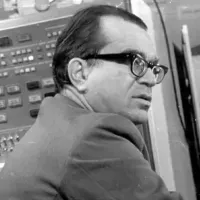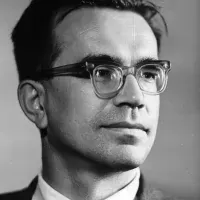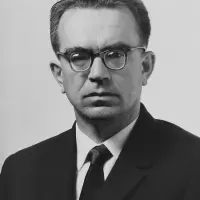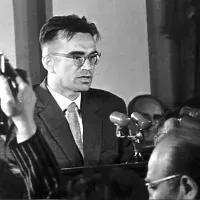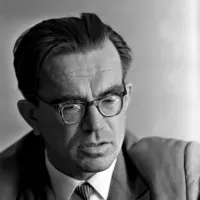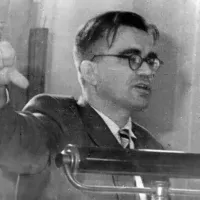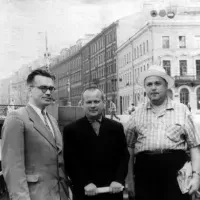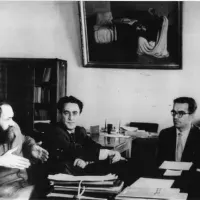Viсtor Mikhailovich Glushkov was born on August 24, 1923 in Rostov-on-Don in the family of Mikhail Ivanovich and Vera Lvovna Glushkov. On June 21, 1941, V.M. Glushkov graduated from secondary school No. 1 in Shakhty with "excellent". V. M. Glushkov 's mother was shot by the Nazis in the autumn of 1941 . After the liberation of Shakhty, V. M. Glushkov was mobilized and participated in the restoration of the Donbass coal mines. The Glushkovs are an ancient family of Don Cossacks. The ancestor of V.M. Glushkov distinguished himself during the Patriotic War of 1812, was the adjutant of the ataman M.I. Platov during the Battle of Borodino, ended the war in 1814 in Paris as a colonel, for numerous feats he was awarded and received a noble rank..

Victor Glushkov with his parents
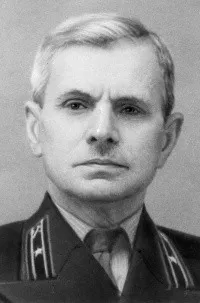
Father Mikhail Ivanovich Glushkov

Mother Vera Lvovna Glushkova
Education
After the announcement in the fall of 1943 of the admission of students to Novocherkassk Industrial Institute V.M. . Glushkov became a student of the thermotechnical faculty of this institute, at the same time he studied at the mathematical faculty of Rostov University. Having defended his thesis in 1948, V. M. Glushkov was assigned to the Urals. In 1948 he married V.M. Papkova, with whom he lived happily all his life, had two daughters, Olga and Vera.

V.M. Glushkov in his youth

Valentina Mikhailovna Glushkova
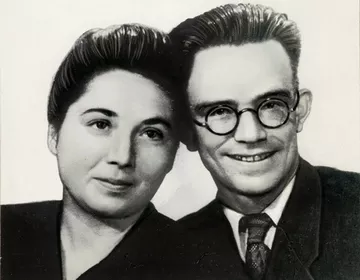
Glushkov V.M. with my wife
The eldest daughter of V.M. Glushkov Olga Victorovna Kitova (Glushkova) – Doctor of Economic Sciences, Head of the Department of Informatics, Plekhanov Russian University of Economics. The Youngest Daughter Vera Victorovna Glushkova – Candidate of Physics and Mathematics Sci., Senior Research Fellow, V.M. Glushkov Institute of Cybernetics, NASU.
The life path of V.M. Glushkov
In Sverdlovsk (now Yekaterinburg), V. M. Glushkov met Professor S.N.Chernikov, Dean of the Faculty of Mathematics of Sverdlovsk University, and on his recommendation got a teaching job at the Forestry Institute, entered the correspondence graduate school of Sverdlovsk University and in October 1951 defended his PhD thesis on "The theory of locally nilpotent groups without torsion with the condition of breaking some chains of the subgroup", was appointed to the position of associate professor.

A post-graduate student's book of the Ural State University
Solution of the fifth generalized Hilbert problem
In 1952, the attention of V. M. Glushkov was attracted by Hilbert's fifth problem, connected with the theory of topological groups, which was posed by the famous German mathematician in 1900 among the 23 largest and most complex problems in mathematics. It is known that the solution of each Hilbert problem became a sensation in world science. Separate private tasks related to this problem were solved by 1952 . However, by that time, the generalized fifth problem of Hilbert had been formulated in the theory of topology, and V.M. Glushkov managed to solve it by working continuously for three years. The solution of Hilbert's generalized fifth problem was the subject of V. M. Glushkov's doctoral dissertation on the topic "Topological locally nilpotent groups", which he defended in 1955 at Moscow University, being attached to the doctoral program of a prominent specialist in higher algebra Professor A.G. Kurosh. The mathematical results obtained by V. M. Glushkov made him one of the leading algebraists of the world, the solution of the generalized fifth Hilbert problem, the study of the properties and structure of locally compact groups and Lie algebras made it possible to significantly develop the theory of topological groups and topological algebra in general.
Management of the Institute of Cybernetics of the Academy of Sciences of the Ukrainian SSR
After the successful defense of his doctoral dissertation, V.M. Glushkov received several job offers and chose the one that was associated with the development of computer technology, cybernetics, computer science and applied mathematics. From August 1956, V. M. Glushkov lived and worked in Kyiv. Here he headed the Laboratory of Computer Science and Mathematics of the Institute of Mathematics of the Academy of Sciences of the Ukrainian SSR, previously created by S.A. Lebedev and known for her pioneering developments of computers MESM and SESM. In 1957 V.M. Glushkov headed Computer Center of the Academy of Sciences of the Ukrainian SSR with the rights of a research organization. Five years later, in December 1962, the Institute of Cybernetics of the Academy of Sciences of the Ukrainian SSR was organized on the basis of the Computing Center of the Academy of Sciences of the Ukrainian SSR, with V.M. Glushkov as its permanent director. Under his leadership, the Institute of Cybernetics became the largest research and design center in the USSR in the field of informatics, cybernetics, computer technology and management information systems.

V.M. Glushkov Institute of Cybernetics of the Academy of Sciences of the Ukrainian SSR.
Contribution of V.M. Glushkov to the theory of digital automata
V.M. Glushkov's scientific activity in the period 1956-1982 was connected with the theory of computer science, cybernetics, computer engineering, programming and management information systems and was based on a powerful foundation of domestic mathematical schools. The starting point for V. M. Glushkov's work in the field of the theory of digital automata was the concept of an automaton, introduced by American mathematicians Kleene, Moore and other authors of the famous collection "Automata", published in 1956 at Princeton and published in Russian the same year. At the very beginning of his work in this field , V. M. Glushkov found a much more elegant, algebraically simple and logically clear concept of the Kleene automaton and obtained all the results of the Kleene. V.M. Glushkov understood that due to its great generality, the theory of automata can be applied to develop models of cybernetic systems in a wide variety of applied fields. At the seminar on automata theory organized by V.M. Glushkov, both general issues of this theory and practical issues of synthesis of circuits of the «Kiev» computer, which was then being designed in the laboratory of V. M. Glushkov, were discussed. Participants of this seminar Yu.V. Kapitonova, A.A. Letichevsky and others in the future formed the core of the V.M. Glushkov school in the field of design theory of digital computers.
The main idea uniting the work on digital automata was the possibility of using an algebraic apparatus to represent such objects as computer components, circuits and programs. V.M. Glushkov developed this idea and, most importantly, built the necessary mathematical tools and showed how computer components can be represented through algebraic expressions. Another idea of V.M. Glushkov was connected with the possibility of transformation of algebraic expressions. At the same time, such transformations reflected the processes of work of engineers and programmers on computer circuits and programs. It was this circumstance that made it possible to find adequate models of computer components and manipulate them in the design and manufacturing process.
In 1961, V. M. Glushkov's famous monograph "Synthesis of Digital Automata" was published, later translated into English and published in the USA and other countries.


V.M. Glushkov "Synthesis of digital automata" 1962
Another important theoretical work "Abstract Theory of Automata" was published by V.M. Glushkov in 1961 in the journal Uspekhi matematicheskikh nauk. She created the basis for work on the theory of automata using algebraic methods. In 1964, for a series of works on the theory of automata, V. M. Glushkov was awarded the Lenin Prize. The significance of these works can hardly be overestimated, since the use of the concept of "automatic" as a mathematical abstraction of the structure and processes occurring inside computers, opened up completely new possibilities in the technology of creating computers. Modern computer design automation systems use these ideas everywhere.

At the rally on the occasion of the award of V.M. Glushkov Lenin Prize, on the left Paton B.E. President of the Academy of Sciences of the Ukrainian SSR. V.M. Glushkov in the center. On the right, Derkach V.P.
In 1964, V. M. Glushkov was elected a full member of the USSR Academy of Sciences in the Department of Mathematics (mathematics, including computational mathematics).
V.M. Glushkov's contribution to the theory of programming and systems of algorithmic algebras
In the field of programming theory and systems of algorithmic algebras, V.M. Glushkov made a fundamental contribution in the form of the algebra of regular events. These results were published by him in 1961 in the journal "Successes of Mathematical Sciences" and in 1965 in the journal "Cybernetics". The apparatus of algorithmic algebra systems (CAA) was developed, which is a two-base algebraic system consisting of a generative algebra of operators and an algebra of three-valued logical conditions. As part of the development of this theory, V.M. Glushkov anticipated the concept of structural programming proposed by Dijkstra in 1968, and proved the fundamental theorem on regularization (reduction to a structured form) of an arbitrary algorithm, in particular a program or firmware. Initially, algorithmic algebra systems were used by V.M. Glushkov to describe firmware. To this end, he proposed an abstract computer model representing the interaction of two automata — a control and an operating one. The automatic interaction scheme adopted in the abstract computer model could be extended to the case of arbitrary cybernetic systems, which makes it possible to formalize their functioning using the apparatus of algorithmic algebra systems. The Glushkov regularization theorem mentioned above was not noticed and understood in a timely manner, later it was overlapped within the framework of structural programming.
The monograph by V. M. Glushkov, G. E. Tseitlin and E. L. Yushchenko "Algebra, languages, programming", containing an introduction to the theory of universal algebras, taking into account the application of this apparatus in theoretical programming, was published in 1974. It is important to emphasize that in connection with research on the formalization of languages, verification of programs and their optimization at the junction of mathematical logic and programming theory in the mid-70s, a new direction in algorithmic (program) logic and process logic emerged. The prototype of propositional programming logics were the systems of algorithmic algebras studied by V.M. Glushkov. The Kiev School (E.L. Yushchenko, G.E. Tseitlin, V.N. Redko, etc.) developed these studies in the direction of axiomatization of algorithmic algebra systems as the basis of schematology of structural programming and universal programming logics.

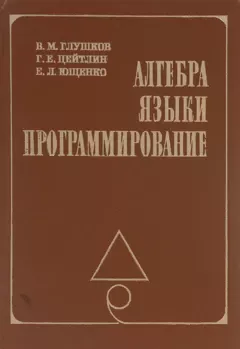
V.M. Glushkov, G.E. Zeitlin and E.L. Yushchenko "Algebra, Languages, Programming" 1978
The systems of algorithmic algebras (SAA) apparatus was used to formalize the semantics of the address language (also developed by the V.M. Glushkov school as part of the work on programming automation), in the development of the implementation of the address language on "Dnepr-2", a model of a two-way parallel analyzer of the Kobol language on an EC computer, components of cross-systems software specialized mini- and micro-computers on EC computers. A project of programs "Analyst" was proposed for proving identities (theorems) in axiomatized system of algorithmic algebras (G.E. Zeitlin — 1979). In 1979-1983 V.M. Glushkov, G.E. Zeitlin, E.L. Yushchenko, V.P. Gritsai published their results on the analysis and synthesis of parallel programs, multilevel structural design of programs. The "MULTIPROCESSOR" system was developed — a structural synthesizer of algorithms and programs based on their projects, designed in the language of the ultra-high level of the SAA, implemented in 1981 in the DOS EC computer. These results were further developed in the method of multilevel structural design of classes of algorithms and programs (sequential and parallel), which is based on structural design grammars combining the SAA apparatus with parallel derivability mechanisms developed in the theory of language processors of the V.M. Glushkov school. In order to create integrated tools for the production of programs, this school proposed a combination of transformational methods (A.P. Ershov), inductive (Ya.M. Bardzin, A.I. Brazma, E.B. Kinber) and deductive (E.H. Tyugu) program synthesis.
Development of new computers and computer design computer "PROEKT"
V.M. Glushkov saw ways to improve the technology of program development in the development of the algebra of algorithmic languages, i.e. the technique of equivalent transformations of expressions in these languages. He put a general mathematical and even philosophical meaning into this problem, considering the creation of the algebra of the language of a specific field of knowledge as a necessary stage of its mathematization. Comparing numerical and analytical methods for solving problems of applied mathematics, V.M. Glushkov argued that the development of general algorithmic languages and the algebra of such languages would lead to expressions in these languages (today's computer programs) becoming as familiar, understandable and convenient as analytical expressions are today. At the same time, the difference between analytical and general algorithmic methods will virtually disappear, and the world of computer models will become the main source of the development of new modern mathematics, as it is happening now.
Modern computers cannot be designed without automation systems for design work. The possibility of using computers in the process of designing computers became real after the corresponding sections of abstract and structural theory of automata were created in the early 60s, which allowed solving a number of problems arising in the process of designing electronic circuits. Further development of the computer design methodology required new techniques, in particular the development of block synthesis methods.The foundations of the theory of computer designwere laid in the articles of V.M. Glushkov, published in the journal "Cybernetics" in 1965-1966 and in the Bulletin of the USSR Academy of Sciences in 1967. It soon became clear that for the effective use of computers in the design process, a comprehensive solution of all the problems arising from design automation within the framework ofdesign automation systems (computer CAD) is necessary. Already in the early 70s, V.M. Glushkov, Yu.V. Kapitonova and A.A. Letichevsky noted a tendency to merge the computer design process with the design and development of their system software.
Based on the theoretical work of V.M. Glushkov at the Institute of Cybernetics, a language for describing computer algorithms and structures and a computer design methodology were created, which were implemented in a number of unique"PROJECT" systems("PROJECT-1", "PROJECT-EC", "PROJECT-MIM", "PROJECT-MVK"). The development of the experimental system "PROJECT-1" on the M-220 machine was completed in 1970. The more powerful system"PROJECT-2" was then implemented on the two-machine complex M-220, BESM-6 with a developed system of peripheral devices. The total volume of the PROJECT-2 system was 2 million machine commands. It was a distributed specialized software and hardware complex with its own operating system and a specialized programming system. In it, for the first time in the world, V.M.Glushkov, A.A. Letichevsky, Yu.V. Kapitonova automated (and with optimization) the stage of algorithmic design. A new technology for designing complex programs was developed — the method of formalized technical tasks. Over time, the "Project" systems were transferred to EC computers and became the prototype of CAD computers and CAD Large integrated circuits in many organizations of the former USSR.Monograph by V.M. Glushkov, Yu.V. Kapitonova and A.A. Letichevsky's "Computer Design Automation", summarizing the experience of creating "PROJECT" systems, was published in 1975. For their work on computer design automation, V.M. Glushkov, V.P. Derkach and Yu.V. Kapitonova were awardedthe USSR State Prize in 1977.

Victor Mikhailovich Glushkov
A great contribution was made by V.M. Glushkov to the creation of computer equipment, to the development of new architectures of computers and systems. In 1958, V. M. Glushkov proposed the idea of creating auniversal control machine. The idea was implemented in a wide—purpose control machine (UMSHN) in a record short time - three years. V.M. Glushkov and B.N. Malinovsky were the leaders of the work on the creation of UMSHN. The basic principles of the construction of the machine, formulated by V.M. Glushkov and B.N.Malinovsky: a semiconductor element base, highly reliable protection of programs and data, a small machine word size (26 digits) sufficient for process control tasks, and, most importantly, a universal communication device with an object. These principles were implemented both in the development of the UMSHN, later called theDnepr computer, and in the subsequent developments of other control machines. The transition from specialized control machines based on the technical base of the first generation (lamp) to universal semiconductor was important from the point of view of the organization of their industrial production and wide application in the automated control systems.
The first"Dnepr" computers were produced by the Kiev plant "Radiopribor". At the initiative of V. M. Glushkov, the construction of the VUM plant (later the Kiev NGO "Electronmash") was started in Kiev, which produced Dnepr machines for 10 years[2].
In parallel with the creation UMSHN initiated by V. M. Glushkova B.N. Malinovsky, A.I. Nikitin and V.M. Egypt works were carried out to control complex technological processes at a distance (with the help of Computer «Kiev»): steel smelting in a Bessemer converter at a metallurgical plant in Dneprodzerzhinsk and a carbonization column at a soda plant in Slavyansk.
Computers dfor engineering calculations. The first machine of this class was Computer «Promin», which has been produced since 1963 by the Severodonetsk Instrument-Making Plant. It was the first machine with step microprogram control, which later V.M. Glushkov received a copyright certificate. It was followed by cars MIR-1 (1965), MIR -2 (1969) and MIR-3.
Their main difference from other computers was the hardware implementation of a machine language close to a high-level programming language. Computers of the MIR family interpreted the ALGOL-likelanguage "Analyst", developed at the Institute of Cybernetics under the leadership of V.M. Glushkov by A.A. Letichevsky, Yu.V. Blagoveshchensky, A.A. Dorodnitsyna. The MIR-1 computer development team headed by V. M. Glushkovwas awarded the USSR State Prize.
In the late 60s, under the leadership of V. M. Glushkov, the development of the "Ukraine" computer was started - the next step in the development of computer intellectualization and the development of high—performance mainframe architecture, different from the architectural principles of J. von Neumann. The computer "Ukraine" was not built due to the lack of the necessary element base at that time. The ideas put by V.M. Glushkov as the basis of the Ukraine project largely anticipated what was used in American mainframes of the 70s.Monograph "Computing machine with advanced interpretation systems" written by V.M. Glushkov, A.A. Barabanov, L.A. Kalinichenko, S.D. Mikhnovsky, Z.L. Rabinovich, was published in 1970. It contained a theoretical justification for the development of computer architecture in the direction of implementing high-level languages.
In 1974, V. M. Glushkov made a report on arecursive computer at theIFIP Congress (co-authors V.A. Myasnikov, M.B. Ignatiev, V.A. Torgashov). He expressed the opinion that only the development of a fundamentally new non-Neumann architecture of computing systems will solve the problem of creating supercomputers whose performance increases indefinitely with increasing hardware. The idea of building a recursive computer supported by a powerful mathematical apparatus of recursive functions was ahead of its time and remained unrealized due to the lack of the necessary technical base.
At the IFIP Congress in 1974 in Stockholm, V.M. Glushkov was awarded a special award —a silver core by the decision of the IFIP General Assembly. Thus, the scientist's great contribution to the work of this organization was noted as a member of the Program Committee of the Congresses of 1965 and 1968, as well as as Chairman of the Program Committee of the Congress of 1971.
In the late 70s, V. M. Glushkov proposed the principle of amacroconveyor architecture of a computer with many streams of commands and data (MIMD architecture according to modern classification) as a principle of implementation ofnon-Neumann architecture and received an author's certificate for this invention. The development of a macroconveyor computer was carried out at the Institute of Cybernetics under the leadership of V.M. Glushkov, S.B. Pogrebinsky (chief designer), V.S. Mikhalevich, A.A. Letichevsky, I.N. Molchanov. TheEC-2701 supercomputer (in 1984) and theEC-1766 supercomputer system (in 1987) were transferred to serial production at the Penza VEM plant. At that time, these werethe most powerful computing systems in the USSR with nominal performanceexceeding the milestone of1 billion op./s. At the same time, the multiprocessor system provided almost linear performance growth as computing resources increased and dynamic reconfiguration. They had no analogues in world practice and were the original development of the EC computer in the direction of high-performance systems. See them in action V.M. Glushkov didn't have to anymore.
.
V.M. Glushkov - pioneer of cybernetics
Viсtor Mikhailovich was a recognized authority in the field of cybernetics in the world. He formed on the basis of the works of N. Wiener, K.Shannon, A.I. Kitov, A.A. Lyapunov, S.L. Sobolev, I.A.Poletaev and others. his understanding of cybernetics as a scientific discipline, its methodology and the structure of research sections[3]. About this in the 60s, V.M. Glushkov wrote scientific articles in domestic journals, articles in the British Encyclopedia and in the American Technological Encyclopedia. V.M. Glushkov'smonograph "Introduction to Cybernetics" was published in 1964.


V.M. Glushkov "Introduction to Cybernetics" 1964
Cybernetics was widely interpreted by V. M. Glushkov as the science of general laws, principles and methods of information processing and management of complex systems. Computer technology was considered as the main technical means of cybernetics. This understanding was reflected inthe world's first "Encyclopedia of Cybernetics", prepared on the initiative of V. M. Glushkov and published in 1974 under his editorship. In 1978, the team of editors and those responsible for the sections of the encyclopedia was awarded the State Prize of the Academy of Sciences of the Ukrainian SSR. The encyclopedia covered: theoretical cybernetics (information theory, automata theory, systems theory); economic cybernetics (economic and mathematical models for management information systems of enterprises and industries, transport, etc.); biological cybernetics (models of the brain, human organs, regulatory systems of living organisms); technical cybernetics (management of complex technical systems); computer theory (principles of construction and design of computers and their software); applied and computational mathematics.
Artificial intelligence systems
M. Glushkov presented new ideas for building artificial intelligence systems such as "eye-hand", "reading automaton", "self-organizing system", automation systems of mathematical proofs. He worked on computer simulation systems for such intellectual activity processes as decision-making, mapping of conditions and situations in economic, technical, biological and medical systems. New directions of information science —informatics, proposed by V. M. Glushkov, have been developed.
V.M. Glushkov actively promoted a practical approach to the problem of artificial intelligence as a matter objectively brought to life by the growing power of computers and their penetration into all spheres of human activity. V.M. Glushkov's students and followers successfully develop his ideas and are engaged in research on structural pattern recognition, methods of analysis of images and speech signals, methods of structural analysis of scenes in the field of view of robots, are engaged in neurocomputer technologies and medical information systems. Glushkov believed that the consistent accumulation of knowledge and effective ways of processing them, the development of intellectual abilities of computers will provide a breakthrough in the development of civilization and ensure the transition to aninformation society.
V.M. Glushkov - an ideologist and one of the founders of the ACS industry in the USSR
V.M. Glushkov paid great attention to the work on the creation of management information systems (MIS) based on the use of computer technology. He was the main ideologist and one of the main creators of the management information system industry in the USSR. The main works of V.M. Glushkov and his school covered a wide range of applications: automated process control systems; automation systems for scientific research and testing of complex industrial facilities; automated systems for organizational management of industrial enterprises (ASU).
V.M. Glushkov, together with his students and colleagues, made a great contribution to the formation and implementation of the ideas of creating a automated control system, the development of appropriate theory, mathematical, software and special technical means for controlling technological processes in microelectronics, metallurgy, chemical industry, shipbuilding. Automation of experimental scientific research in the early 60s was associated with automation of measurements and processing of the received information using the controlcomputer "Dnepr". Then V.M. Glushkov proposed to develop automated problem-oriented laboratories with the help of academic institutes, including complexes of measuring instruments, computers (micro- or minicomputers) and measurement processing programs. 5-6 such standard laboratories were planned for X-ray diffraction analysis, mass spectrography and other experimental research methods used in chemistry, physics, biology. To process the results of complex nuclear experiments, such laboratories were proposed to be connected to remote computers such as BESM-6 or EC-1060. Since most scientific experiments are not limited to data collection and processing, but require fine-tuning of the experimental facilities themselves, V.M. Glushkov set the task of automating the setup operations of these facilities. By the efforts of specialists of the Institute of Cybernetics, tests for mechanical fatigue of materials were automated at the Institute of Strength Problems of the Academy of Sciences of the Ukrainian SSR, experimental studies at the Institute of Geology and Geophysics, the Institute of Oncology Problems of the Academy of Sciences of the Ukrainian SSR. Works on automation of tests of complex industrial facilities were carried out for the navy and aviation. For the future, V.M. Glushkov saw prospects in this area for the development of algorithms for deductive constructions so that the system not only processes measurement results, but also checks hypotheses and builds theories on this basis, i.e. performs the role of an artificial intelligence system in a given subject area.
The development of automated organizational management systems for enterprises was started under the leadership of V. M. Glushkov in 1963-1964. In 1967, the first management information system in the country was put into operation and recommended for replication for an enterprise with a mass production at theLviv television plant "Electron".
In 1970, when the system was already successfully operated, its creators V.M. Glushkov, V.I. Skurikhin, A.A. Morozov, V.V. Shkurba and others were awarded the State Prize of the Ukrainian SSR. After the creation of theLviv system, V.M. Glushkov set the task of creating not an individual, but a standard management information system for machine and instrument-making enterprises. In the early 70s, work was completed on the"Kuntsevo" system (for the Kuntsevo radio plant), which V.M. Glushkov proposed to lay the foundation for the creation of a management information system at the enterprises of nine defense ministries.
For the construction of standard management information systems, V.M. Glushkov in 1965 put forward the concept of a specialized operating system designed for systems with a regular flow of tasks, in contrast to the operating systems of IBM/360 mainframe computers, which solve random task flows and are good for the batch mode of computing centers. V.M. Glushkov'smonograph "Introduction to Management Information Systems",which was devoted mainly to organizational management systems, was published in the second edition in 1974. It systematized the original results obtained by V.M. Glushkov in 1964-1968.


V.M. Glushkov "Introduction to Management Information Systems" 1974
The work on the creation and implementation of management information systems in practice has not always been successful. The reasons for this phenomenon lay in the sphere of the planned socialist economy that was then in effect in the USSR, forcing enterprises to "drive the shaft of production" without caring about optimizing the technical and economic indicators of production, the quality of manufactured products, scientific and technological progress.
Since the late 60s, the creation of industrial management information systems (OASU) has become relevant. V.M. Glushkov, as the most qualified and authoritative specialist in this field, in the 70s was a scientific supervisor and consultant for many projects of large OASU, in particular in the defense industry. When the Interdepartmental Committee of nine branches and the Board of Directors of the Main Institutes of the defense industries for management, economics and computer science were created in the defense complex, V.M. Glushkov became the scientific director of the committee and the Council. He was the scientific director of a number of large branch OASU, such as the OASU of the Ministry of Instrument Engineering, the OASU of the Ministry of Defense Industry, other OASU of the defense ministries, the Republican ASU in the Ukrainian SSR, ASU "Moscow", ASU "Olympiad-1980", ASU of the Armed Forces of the USSR and other systems.
OGAS project – the world's first holistic digital state project
In 1962, on the instructions of A.N. Kosygin, at that time Deputy Chairman of the Council of Ministers of the USSR, V.M. Glushkov began developing a project for a nationwide automated system for collecting and processing information for accounting, planning and management of the National Economy (OGAS). Starting the creation of the OGAS project, V.M. Glushkov personally studied the work of more than a thousand objects of the national economy: factories of various industries, mines, railways, airports, supreme governing bodies — Gosplan, Gossnab, CSU, Ministry of Finance, etc. He worked on the application of macroeconomic models and methods of improving public administration techniques in OGAS, which was reflected in his monograph "Macroeconomic models and principles of building OGAS". V.M. Glushkov proposed the concept of OGAS as a unified system for collecting accounting information on the national economy, planning and management of the national economy, an information base for modeling various options for the development of the national economy.


Glushkov V.M. "Macroeconomic models and principles of building OGAS" 1975
The technical basis of the OGAS was to be the Unified Network of Computing Centers (EGSVTs)[4].
In the pre-sketch project of the EGSVC, developed under the guidance of V.M. Glushkov in 1964, unlike the previous concept of the network proposed by economists led by V.S. Nemchinov, V.M. Glushkov justified the construction of a network of about 100 large centers in industrial cities and centers of economic districts connected by broadband communication channels with message switching and related 20 thousand centers of enterprises and organizations. The creation of a distributed data bank and the development of a system of mathematical models of economic management were envisaged.
Of course, V.M. Glushkov understood that with his plan he was challenging the usual canons of managing the country's economy. And indeed, the OGAS project submitted to the Government in 1964 met with sharp demagogic objections from the leadership of the CSU of the USSR (V.N. Starovsky), then it was processed for a long time in the CSU of the USSR, the State Planning Committee of the USSR, but it was never implemented. The incompetence of the top management of the country, the unwillingness of the middle bureaucratic level to work under strict control and on the basis of objective information collected and processed using computers, the unpreparedness of society as a whole, the imperfection of computer technology and communication tools that existed at that time, misunderstanding, and even opposition from economists prevented the creation of the OGAS. In fact, the concepts of the OGAS and the EGSVC, which correctly reflect in technical terms the rigidly centralized structure of the country's social structure, have met resistance from the public system itself.
V.M. Glushkov was certainly right when he set the task of informatization and computerization of the country more than 40 years ago. But in those conditions, he could not do anything without large-scale decisions of the Government and the Central Committee of the CPSU, which became a barrier on this path. In the archive of V.M. Glushkov there are quite a lot (on average one in two months) copies of notes to high party and economic authorities on the policy of development and use in the economy, defense capability, management of the country's economy, education achievements of computer technology and automated systems. According to his notes, it is possible to compile a list of unrealized cases that could not be carried out within the framework of the social system in force at that time. And this was a tragic part of his life. Like no one else, he understood that this leads to the death of the social system and, as further historical events have shown, the country as a whole.
V.M. Glushkov's civic position was active. More than 250 of his publications in popular scientific and public publications, regular cycles of lectures that he gave to the public and the top management of the country, testify to this.
V.M. Glushkov - organizer of science, teacher and public figure
Academician V.M. Glushkov conducted extensive and multifaceted scientific and organizational activities as director of the country's largest Institute of Cybernetics of the Academy of Sciences of the Ukrainian SSR, which he created in 1962 and which he led until the end of his days. In the late 1970s and early 1980s, the Institute of Cybernetics of the Academy of Sciences of the Ukrainian SSR employed more than five thousand employees who solved important fundamental and applied scientific and technical problems in the interests of various sectors of the economy and the Armed Forces of the USSR.
From 1962 until the end of his life he was Vice-President of the Academy of Sciences of the Ukrainian SSR.
Since 1963, V.M. Glushkov has been chairman of the Interdepartmental Scientific Council for the Introduction of Computer Technology and Economic and Mathematical Methods in the National Economy of the USSR under the State Committee of the Council of Ministers of the USSR for Science and Technology. He took an active part in the planning and management of scientific and technological progress in our country.
In the 1960s, V.M. Glushkov was an adviser to the UN Secretary-General on cybernetics and computer technology and their use in developing countries.
Academician V.M. Glushkov was an ideologist and one of the main creators of the management information system industry in the USSR, which employed about 800 thousand people. He was a scientific supervisor and consultant of many industrial and republican management information systems in the Soviet Union, in the People's Republic of Bulgaria and in the German Democratic Republic, organized the work of thousands of people. He was the scientific director of the interdepartmental committee and the Board of Directors of the main institutes of the defense industries for management, economics and computer science, defining the main directions of development of management information systems in these industries.
V.M. Glushkov was an active and talented popularizer of science, thousands of people listened to his lectures with great interest, he wrote more than 250 articles about cybernetics, computer science, computer technology, ACU, OGAS and the digital state, artificial intelligence and information society in popular scientific and socio-political publications.
V.M. Glushkov was a talented teacher. He began his career in 1948 as a teacher at the Ural Forestry Institute (Sverdlovsk, now Yekaterinburg). In 1957, he began working as a professor at the Taras Shevchenko Kyiv State University, where since 1966 he headed the Department of Theoretical Cybernetics created by him. He was one of the organizers of the Faculty of Cybernetics of Kiev State University, created the Kiev branch of the Moscow Institute of Physics and Technology and successfully taught at MIPT.
V.M. Glushkov was a deputy of the Supreme Soviet of the USSR of several convocations, conducted extensive public work, represented Soviet science abroad.
V.M. Glushkov - pioneer of informatics
V.M. Glushkov developed the ideas of the information society. "Fundamentals of Paperless Computer Science" was the title of his last monograph, published in 1982. This book describes the mathematical apparatus and a set of ideas related to the problems of informatization of all aspects of life and the transition to an information society. He paid special attention to informatization of education. The OGAS concept largely anticipated the ideas of e-government, the digital state and the digital economy


V.M. Glushkov "Fundamentals of paperless informatics" 1982
For his great contribution to the development of science and technology and the application of these achievements in the national economy, Victor Mikhailovich Glushkov was awarded the title of Hero of Socialist Labor, awarded many government orders and medals, including three Orders of Lenin, the Order of the October Revolution, the Order of the People's Republic of Bulgaria, 1st degree, the Order of the Banner of Labor of the GDR and others.
V.M. Glushkov was elected a member of the German Academy "Leopoldina", a foreign member of the Academy of Sciences of Bulgaria, of the GDR and Poland, an honorary doctor of the University of Dresden, an honorary member of the Polish Cybernetic Society. From 1962 until the end of his life he was Vice-president of the Academy of Sciences of the Ukrainian SSR.
Many wonderful people worked under the leadership of V.M. Glushkov. He can rightfully be considered the founder of the school in the field of cybernetics and computer science, he has more than a hundred direct students who have defended candidate and doctoral dissertations. Under his leadership, the staff of the Institute of Cybernetics of the Academy of Sciences of Ukraine was formed, on the basis of which a Cybernetic Center was created in 1993, which includes the V.M. Glushkov Institute of Cybernetics, the Institute of Problems of Mathematical Machines and Systems (formerly SKB MMC), the Institute of Software Systems (formerly SKTB PO), the Institute of Space Research, the Institute of System Analysis and the International Research Training Center. The team of V.M. Glushkov's students and followers includes many leading specialists working in Russia, Ukraine, Belarus, Uzbekistan and other CIS countries, in the USA, Germany, Bulgaria, Hungary.
Victor Mikhailovich Glushkov was a charming, cheerful, sociable and encyclopediically educated person, fluent in English and German, knew and loved poetry, music, philosophy, physics, chemistry, astronomy, and was fond of radio engineering since childhood. He gave himself to the people he communicated with, created an aura of creative search, inspiration, and an amazing sense of involvement in new, important and interesting activities.

B . M. Glushkov on a fishing trip

B . M. Glushkov on a fishing trip
V.M. Glushkov has published more than 800 printed works. Of these, more than 500 were written by him personally, and the rest were written jointly with his students and other co—authors. This result of the scientist seems surprising, especially in connection with his own admission that he writes articles slowly and this is a difficult task for him. And when he is loaded with the duties of the director of the institute and consultant of many large systems projects in the USSR and his demands on the quality of scientific products, this is all the more surprising. The only explanation for this phenomenon is that V.M. Glushkov was a true ascetic in science, who possessed gigantic efficiency and diligence.
V.M. Glushkov as a thinker was distinguished by the breadth and depth of scientific vision, with his works he anticipated what is now appearing in the modern information society. During his lifetime, he generously shared his knowledge, ideas and experience with the people around him. And, of course, he wanted to leave his scientific legacy to posterity. In January 1982, while in the intensive care unit, V.M. Glushkov dictated to his daughter Olga stories about his life path, summing up his creative biography. The text of these notes, together with an autobiography compiled from the stories of V.M. Glushkov in the early 70s to journalist V. P. Krasnikov about childhood, youth and the first years of scientific activity, is published in the books of B.N. Malinovsky "Academician V. Glushkov. Pages of life and creativity" and "The history of computer technology in persons" (chapter "The main business of life").
Viktor Mikhailovich died on January 30, 1982, when he was only 58 years old. He is buried in Kiev at the Baykovoye cemetery.

[1] On the solution to the fifth problem Hilbert (whether any locally Euclidean topological group is a Lie group with an appropriate choice of local coordinates) was studied by American scientists Glisson, Montgomery, Zippin, the outstanding Russian algebraist A.I. Maltsev. V.M. Glushkov obtained a stronger result than the American scientists, moreover, using a simpler method, which is also better suited for studying the usual (rather than generalized) Hilbert's fifth problem.
[2] In the US, the development of a universal the control machine was started a little earlier, but its launch into production was carried out in 1961, i.e. almost simultaneously with the Dnepr machine.
[3] Even before arriving in Kiev, living in Sverdlovsk, V.M. Glushkov in 1956 read an article by S.L. Sobolev, A.I. Kitov and A.A. Lyapunov "The main features of cybernetics" and the book by A.I. Kitov "Digital computers" - the first domestic textbook on programming, computers and their applications.
[4] Note that starting Since 1958, proposals for the creation of a unified state network of computer centers for managing the country's economy were formulated by A.I. Kitov in his works "Electronic computers", "Cybernetics and management of the national economy" and others. In 1959 he sent his draft ("Red Book") to the head of the USSR N.S. Khrushchev, in which he proposed the creation of the EGSVTs to manage the country's economy and armed forces.
Photo
Awards
He was awarded the title of Hero of Socialist Labor, awarded three Orders of Lenin, the Order of the October Revolution, the Order of the People's Republic of Bulgaria, 1st degree, the Order of the Banner of Labor of the GDR, etc. He was awarded the Lenin and two State Prizes of the USSR.
Awards and prizes of the USSR
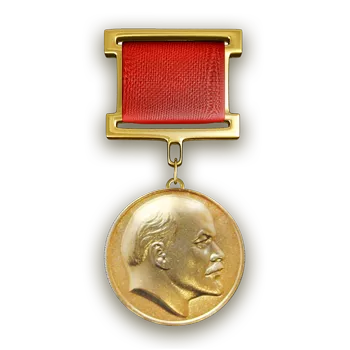
Lenin
Prize
1964

twice winner
State Prize of the USSR
1968, 1977

Hero of Socialist Labor
1969
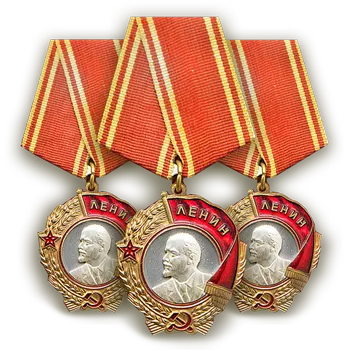
3 orders
Lenin
1967,1969,1975

Order
October Revolution
1973
International awards

Medal «Computer Pioneer»
IEEE Computer Society
1996
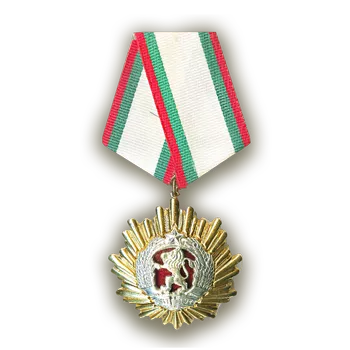
the Order of the People's Republic of Bulgaria
( the 1st degree)
1974
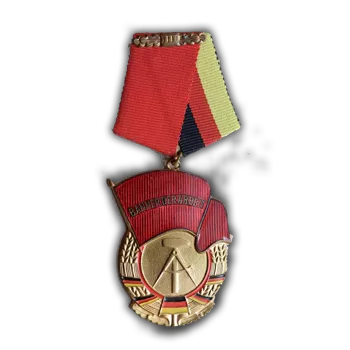
the Order of the Banner of Labor of the GDR
1965




